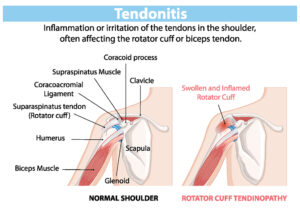What the—That Shoulder Pain? Discover the Real Solutions!
By Adrian Lorenzo, PT, DPT ///
From the Field to Everyday Life: A Deep Dive into Shoulder Pain, Its Causes, and the Power of Physical Therapy
Shoulder pain isn’t just an issue for professional athletes—it affects active adults across all walks of life. Whether you’re a competitive swimmer, a weekend tennis player, or simply someone who values an active lifestyle, shoulder pain can interrupt your routine and overall quality of life. In this post, we’ll examine the most common causes of shoulder pain, explore realistic and pragmatic solutions, and highlight how a well-designed rehabilitation program, led by skilled physical therapists, makes a difference.
The Many Faces of Shoulder Pain
Common Causes
• Overuse and Repetitive Strain: For elite athletes and fitness enthusiasts, repetitive overhead movements can cause cumulative damage over time. Take professional baseball pitchers or tennis players—they put tremendous strain on their shoulders, often leading to rotator cuff tendinitis or impingement syndrome. Even in the general population, repetitive motions at work or during exercise can lead to similar problems.
 • Traumatic Injuries and Acute Incidents:
Accidents, falls, or sudden impacts can result in acute injuries like:
• Traumatic Injuries and Acute Incidents:
Accidents, falls, or sudden impacts can result in acute injuries like:
– Rotator Cuff Injuries: Overuse, acute trauma, or repetitive motions can strain the rotator cuff muscles and tendons, leading to tears or inflammation.
– Tendinitis: Inflammation of the tendons due to repetitive overhead movements or aging can result in pain and reduced mobility.
– Bursitis: The bursa—a small, fluid-filled sac that cushions the joint—can become inflamed, often as a result of overuse or injury.
– Frozen Shoulder: Also known as adhesive capsulitis, this condition involves stiffness and pain due to thickening and tightening of the joint capsule.
Professional athletes, who operate at high intensity, are particularly prone to these incidents, while active adults may face similar risks during recreational activities.
• Degenerative Changes: As we age, the wear and tear on our joints can lead to conditions such as osteoarthritis or frozen shoulder (adhesive capsulitis). Although these conditions are more familiar with aging, they can affect individuals in their late 20s through their 60s, especially if there’s a history of shoulder stress.
– Arthritis: Osteoarthritis and Rheumatoid arthritis can cause joint pain and inflammation, affecting the shoulder’s range of motion.
Understanding the underlying cause is essential to guiding the treatment plan and recovery process.
Recognizing the Symptoms
Shoulder pain can present in several ways. Being mindful of these symptoms can help you catch issues early:
• Persistent Aching or Sharp Pain: Pain that lingers even during rest or is exacerbated by movement.
• Limited Range of Motion: Difficulty raising your arm or performing overhead activities.
• Weakness: A noticeable decrease in strength, making it hard to lift objects or engage in your usual activities.
• Swelling or Tenderness: Visible inflammation or discomfort when touching the shoulder.
• Popping or Clicking Sounds: Unusual sounds during movement might indicate issues within the joint.
Realistic Solutions Through Targeted Rehabilitation
Physical therapy isn’t just about addressing pain—it’s a comprehensive approach to restoring function, preventing future injuries, and empowering you with the tools to maintain shoulder health. Here’s how a well-structured rehabilitation program can help:
Personalized Assessment and Treatment
• Individualized Evaluations: The physical therapists at Scerbo Physical Therapy and Sports Rehabilitation will assess your shoulder’s range of motion, strength, and movement patterns. This detailed evaluation is critical for identifying the root cause of your pain and tailoring a treatment plan that fits your lifestyle and activity level.
• Targeted Exercise Regimens: Specific exercises to strengthen the rotator cuff, scapular stabilizers, and surrounding muscles are central to recovery. For example, a competitive swimmer might work on endurance and flexibility exercises, while a tennis player may focus on strength and agility drills. For more details, visit our Sports Rehabilitation program.
• Manual Therapy and Modalities: Hands-on treatments—such as joint mobilizations, soft tissue massage, and specific stretching techniques—help alleviate pain and improve mobility. These treatments are often combined with modalities like ice, heat, or electrical stimulation for enhanced relief. Visit our Orthopedics Physical Therapy service page to learn more.
• Education and Prevention: An essential part of the process involves learning proper biomechanics, posture, and self-management strategies. By understanding how to move correctly and strengthen weak areas, you reduce the risk of re-injury. This is particularly beneficial for professional athletes who rely on peak performance and active adults looking to stay fit long-term.
Case Examples in Action
• Professional Athletes: Consider the case of a baseball pitcher dealing with chronic rotator cuff tendinitis. With a personalized physical therapy program focusing on strengthening and correcting faulty throwing mechanics, many athletes return to competitive play and often experience significant improvements. Similarly, elite swimmers with shoulder impingement benefit from targeted mobility exercises that reduce inflammation and enhance stroke efficiency.
• Active Adults: Even if you’re not in the spotlight, you might be a weekend warrior or enjoy regular fitness activities. Imagine a 45-year-old avid cyclist who experiences pain after long rides or a 30-year-old who struggles with shoulder stiffness from desk work combined with an active gym schedule. A structured rehabilitation program that includes corrective exercises and ergonomic advice can not only alleviate current pain but also prevent future issues.
Statistics Backing Up the Benefits of Physical Therapy
According to recent statistics from physical therapy associations like the American Physical Therapy Association (APTA), more than 70% of patients experiencing shoulder pain report significant improvement in function and pain reduction after a structured physical therapy program. Moreover, studies indicate that early intervention with targeted rehabilitation can reduce recovery time by up to 40%, and prevent chronic pain conditions from developing later on.
These statistics aren’t just numbers—they represent real lives transformed by personalized care, education, and a commitment to sustainable, long-term shoulder health. Whether you’re an athlete at the peak of your career or someone working hard to maintain an active lifestyle, the data support the power of physical therapy as a cornerstone of recovery and prevention.
If you’re facing shoulder pain—whether it’s due to overuse, an acute injury, or degenerative changes—consider seeking a consultation with one of our physical therapists at Scerbo Physical Therapy & Sports Rehabilitation. They can provide you with a roadmap to recovery, explicitly tailored to your needs and lifestyle. Embrace the journey to a stronger, healthier shoulder and continue to pursue the activities you love with confidence.
Stay proactive, stay informed, and take charge of your shoulder health! Book your appointment today or call us (201) 941-2240.



